Highway 61 Revisited Shows What It Means To Love Music
Bob Dylan is a poet laureate, the voice of a generation, the great white wonder, Robert Zimmerman, Bob Dylan, is Bob Dylan, he'll be whoever he wants to be. He just decided to be the creator of a masterpiece.
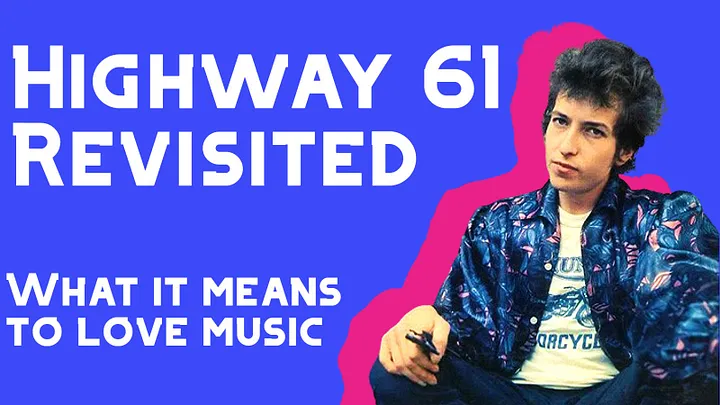
Let's paint a picture, you've been on tour for half a year, 27 shows, North America, England, and you've been singing some songs from your newest album, but most of it is stuff that you wrote years ago, but that's what the crowd wants, creatively, you'd begin to feel like you peaked when you wrote those songs. People love your stuff, but you don't even think you love your stuff. Bob Dylan, May 1965. He was dead, he almost had nothing left in him by this point, he was considering quitting singing all together. What would you do here? Because Bob Dylan wrote arguably his best song of all time. It isn't quite that simple, he had written 20 pages of, in his words, "vomit" which were mangled, expertly so, into the song we call "Like a Rolling Stone". When you write something this good, you know it, he's said it was a ghost that wrote that song in reality, the ghost just chose him. Well they chose the right person, because Dylan's energy towards music was renewed after that, and he was ready to make a new album.
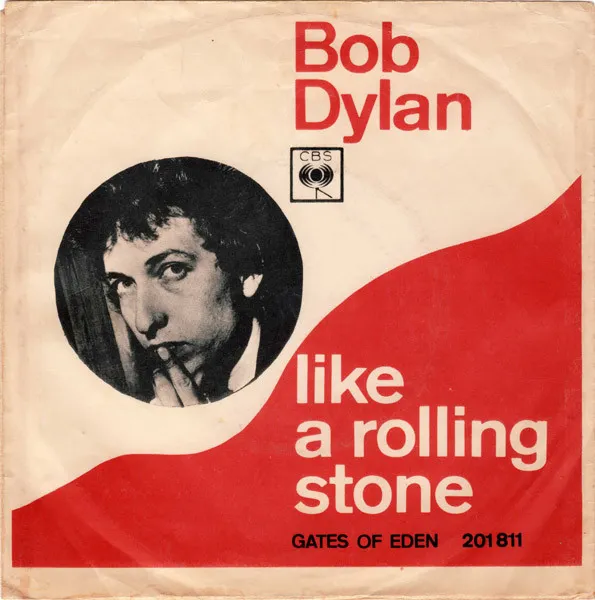
1965 Single of Like a Rolling Stone w/ B-Side of Gates of Eden
The 15th and 16th of June were the days that magic first sparked on the Highway 61 train. He was playing mostly with people he worked with on his previous album, Bringing It All Back Home, but the major shift here was with Bruce Langhorne being replaced by Mike Bloomfield. Now for those who aren't aware, Mike Bloomfield is a legend, most famous for being a member of the Paul Butterfield Blues Band, but also for playing with Dylan at the 1965 Newport Folk Festival, where he went electric. We'll get to that, but he's one of the greatest guitarists of all time. They set up in a Columbia studio in Manhattan, with producer Tom Wilson, who had worked extensively on Dylan's previous albums. This session was only 2 days, so they realistically couldn't have gotten a lot done, but they got through a couple songs on the first day, "Sitting on a Barbed Wire Fence", and a faster take of "It Takes a Lot to Laugh, It Takes a Train to Cry" were both not included on the album. The other song they managed to record was "Like a Rolling Stone", now don't get it mixed up, this wasn't the version you know and love, it's a piano led ballad-esque song with a more jaunty pace. Day 1 gave the album no songs. Day 2 was more successful, but also more focused, they set the entire day towards Like a Rolling Stone, and after 4 takes, they had it. Thanks in part to a studio legend, Al Kooper, who was supposed to just sit in on the session, but ended up playing organ on the song, and the main riff you hear in the final version was all him, not bad for his first time playing organ. For Dylan it was back to writing.
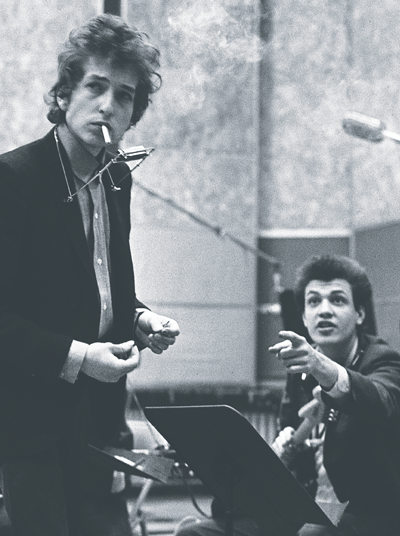
Mike Bloomfield and Bob Dylan taking a break
He went up to his new home in the Byrdcliffe Colony, a colony based on the Arts and Crafts movement, which had been inspiring artists for years. He would finish writing all the songs for the album during his time there, spending about a month simply writing. July 25th, he would play the Newport folk Festival, and "go electric", now it's often overstated how the audience reacted, it wasn't nearly the unanimous booing off-stage it's sometimes made out to be, instead, about half the audience loved it, and cheered, and the other half, mostly folk purist types, were the ones booing. That wouldn't phase him though. After that, he was ready to get back in the studio. He came back on July 29 equipped with his new material, and the players he had worked with on the June sessions. Joe Macho was replaced by Harvey Brooks on bass, but the biggest change was a change in producer, from Tom Wilson to Bob Johnston. Having Wilson produce the album likely wouldn't have made it sound wildly different, but this decision did have an effect on the album, Like a Rolling Stone was given its own identity. The song has a certain je ne sais quoi, thanks in large part to the organ being more abrasive, but also gives it a certain feeling of joy that is just hard to replicate. "Tombstone Blues", "It Takes a Lot to Laugh" and "Positively 4th Street" were the first songs they completed, all in one session, and they managed to get masters of each, "Tombstone Blues" and "It Takes a Lot to Laugh" were put on the album, but "Positively 4th Street" was released as a single, B-sided by "From A Buick 6". At the end of the day they tried to record the 11 minute epic "Desolation Row". They had to do it without their drummer because he had already gone home, so Dylan, Kooper, and Brooks recorded the song and called it a day. The next day "From a Buick 6" was recorded, but the day was actually set on making the song "Can You Please Crawl Out Your Window?" which never made it to the album. The song was put aside, but never made it to any of Dylan's studio albums, but was recorded again with The Hawks, the early name for The Band, this version was released as a single in November 1965, and then made it to the hands of Jimi Hendrix who recorded a version later.
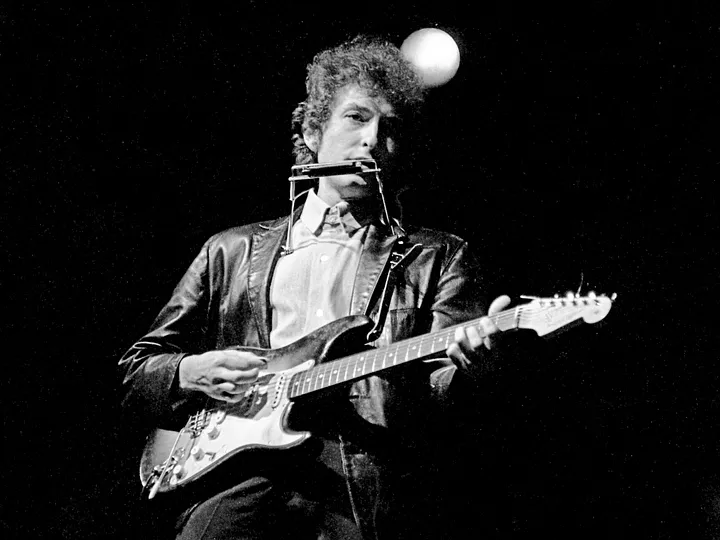
Bob Dylan "going electric" at the Newport Folk Festival; July 25, 1965
Dylan and Kooper took the weekend off and went back to Woodstock to write up chord charts for the songs they hadn't recorded yet, and on August 2nd they went back to the studio, this was their most productive day by far, despite being from 8 PM to 3 AM, with the masters of "Ballad of a Thin Man", "Highway 61 Revisited", "Just Like Tom Thumb's Blues", and "Queen Jane Approximately" being recorded, this was in part due to the head start of Dylan and Kooper's chords. August 4th was the final session, and they decided to nail down "Desolation Row". Charlie McCoy was visiting New York at the time, and was asked to play guitar on the song, which gives us the dual guitar sound we hear on the official song. 7 takes total were made, and they seemingly spliced the last 2 together to make the master. The last thing to happen in the session was Dylan's attempt to add something extra to Tombstone Blues, he attempted to add harmonica to it, but decided against it, and wrapped up the sessions for good. The album cover was shot weeks before the recording, by Daniel Kramer, with Dylan sitting in front and Bob Neuwirth standing behind him with a camera to add extra color to the photo. The back cover features a surrealist poem of sorts by Dylan, "On the slow train time does not interfere & at the Arabian crossing waits White Heap, the man from the newspaper & behind him the hundred inevitables made of solid rock & stone." With that, the album was released, August 30th 1965. Reviews were positive almost across the board, some weren't ready for the shift, but those who got it, really got it. People loved the record, rewarding, knock-out, top-of-the-chart-winner, all things the album was called, and it stood the test of time. Critics then and now give this the biggest acclaim of any of Dylan's work, and it's clear as day why once you listen to the album.
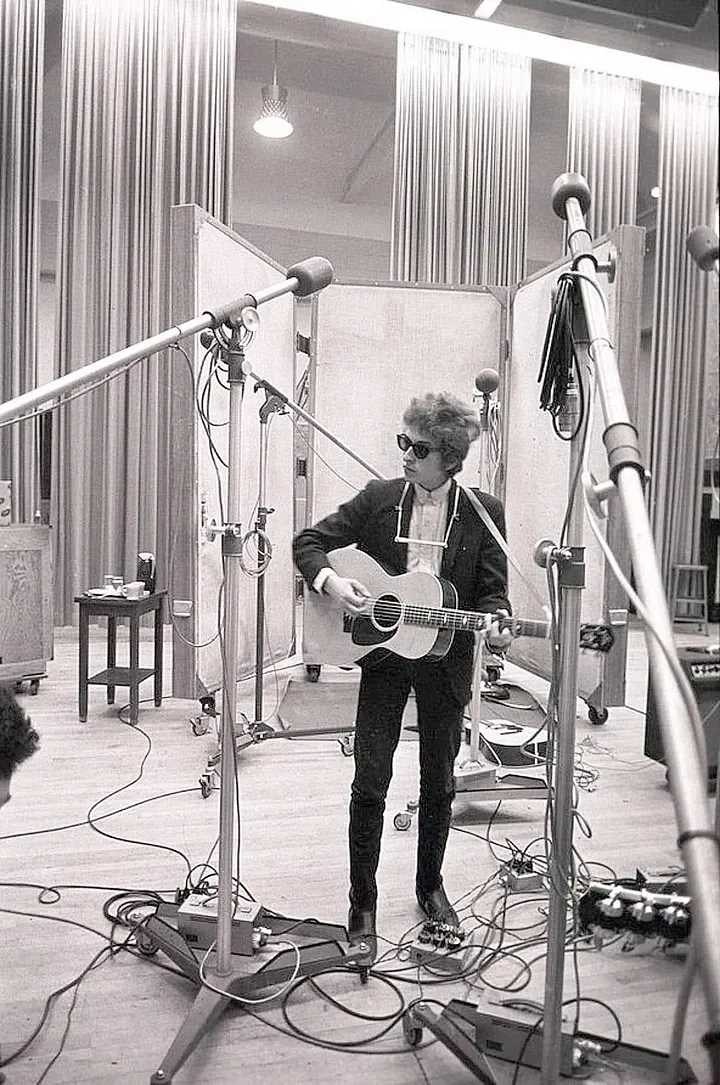
Dylan playing guitar on the August 2nd recording session.
This is an album that runs through every emotion with so much tact and suave and poetic justice that you forget you're even listening to words. From the questioning of your own poverty, and the shallowness of the rich on "Like a Rolling Stone". The psychedelic Leary-esque confused, and confusing power of "Ballad of a Thin Man". The portrait-piece, and highly detailed "Desolation Row". You can dissect and read into the lyrics on this album for weeks and still find new meaning, it often reads as poetry, as Dylan's songs often do. Here though I think his poetic brilliance is on display like never before, the aforementioned "Desolation Row" gives an image so vivid that poets then and now yearn to create something so immaculately realized. "Queen Jane Approximately" gives us a picture of this monarch that is brought to the last straw based on the people around her and their needs and neediness, and Dylan begs for her to "come see me" for "somebody you don't have to speak to". It gives clarity to those who simply put to much pressure and purpose on pleasing those around them, and for them to simply be alone, because it's all a metaphor, Dylan doesn't need to be spoken to, and so don't, just be alone, be quiet, and understand you don't have to please, isolation is the metaphor. "Just Like Tom Thumb's Blues" is a warning bell for all those who try to navigate the world around them, the truth of it all is unraveled in this song, everything we are lead to understand, and believe is always slowly changing, even ourselves, always question everything, nothing is as it seems, that's the message this song gives us. It reads as a life is being lived right in front of our eyes, and if we don't learn from the mistakes they've made, we're bound to make them too. "It Takes a Lot to Laugh, It Takes a Train to Cry" makes us come to terms with ourselves, how, even if our life isn't perfect, and death is inevitable, the things around us are what's beautiful, we may not know where our life is going, but everything around us keeps moving, it's like a vagabond hopping on a train, he doesn't know where it's headed, but it goes regardless, "Don't say I never warned you when your train gets lost" that's really the point of this song, your train will get lost, but if you just keep riding, you'll get to where you need to be. The lyrics on this album are about life, your life, my life, everyone's life, these words put on paper, then into song are a blueprint for everything you'll learn during a lifetime, even if you don't understand them now, you will later, but you still won't understand them all, and as life goes on the pieces come closer and closer together, but when they all click, you will be satisfied with the life you've lived.
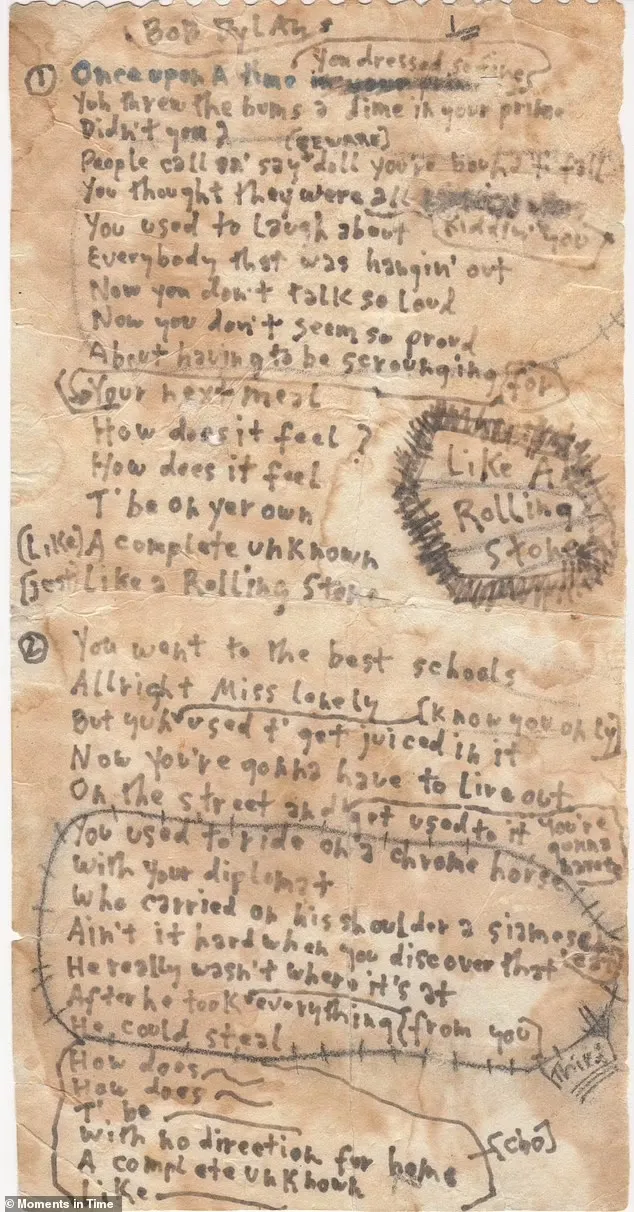
Original handwritten lyrics for Like a Rolling Stone
The sound of this album is something entirely different, it's unique, passionate, humorous at times, and energetic without fail. The transition from acoustic to electric is always going to bring something new and exciting to the mix, but Dylan takes it a step further. The organ that appears throughout this album is the subtle life force behind the energy in this album. The guitar is playing a big role in the rhythm here, it keeps things moving, and it keeps things fresh. The difference from a jaunty upbeat Dylan and a slower, sorrowful Dylan can be the guitar moving from major to minor. The skill shown on this album by Bloomfield is something that's wholly unique to him, and the variety he manages to pull off across these 9 songs is something that's truly special. The piano is another major element, it completely fills out the sound, there's never a blank area here, and that's very much owed to the abrasive and intense piano playing of Paul Griffin. He gives each song its own flare in the form of a more jaunty piece sort of weaving in and out in-between Bob's Singing, or the consistent and ongoing playing on a song like "Ballad of a Thin Man", which only adds to the intensity of the lyrics, and adds to the non-conforming energy it gives off. And while it doesn't appear on all songs, the Harmonica is something that will almost always enhance Dylan when it's in play. A nice harmonica solo will give the song a certain kick that only adds to Dylan himself. It keeps the song from ever becoming stale in any sense of the word. The arguably most important part of the composition is Dylan's voice, one that only complements the words he's saying. Ones who aren't as familiar with him will often knock his vocals, but in reality, he's got a timbre that only he can really master. The subtle deepness, subtle awkwardness at times, it's not flashy in the slightest, but it's fresh. You don't hear people simply singing exactly how the song makes them feel, but doing it in a way that it just seems like he does it so naturally. His singing is something special, and on this album I feel like it's shown in one of its purest recorded forms. His strictly folk albums may have given it more room to breathe, but under constraints it shows that he can shine through what is an already packed album instrumental.
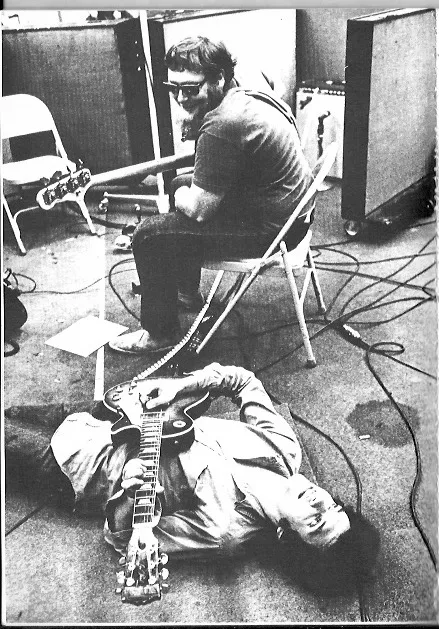
Bassist Harvey Brooks lies on the ground with Mike Bloomfield sitting above him
What this album is to me is something that it is to no one else, and that's the experience everyone should have with this album. Finding your own meaning in music is something that makes it so great, and this album is entirely perfect for that, you will find your own meaning within this piece. All people will find meaning within this piece, the parallels that you can draw between yourself and this album is something that you can do with no other album in the same way. When you relate to this album, you find out something new about yourself, and if you take what it has to say, and not just listen, but understand it, you will become a better version of yourself. Music is a deeply personal experience, and nothing shows that more than this album.